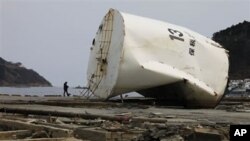Executives at Tokyo Electric Power delivered a stark assessment of the situation at the Fukushima nuclear power plant Wednesday, saying that while reactors one through four are stabilizing, they are still not yet under control.
Airborne radiation readings around the plant are continuing to fall, but workers face a tough job in taming reactors one through four. Tokyo Electric Power Chairman Tsunehisa Katsumata says that, when that job is done, the future of the reactors is clear.
The four stricken reactors will never come back online, said Katsumata. He would not yet commit to the future of reactors five and six at the plant or the nearby Fukushima Daini plant, where smoke was briefly seen coming from one of the reactors. And he acknowledged that the utility company might face strong public opposition to restarting any reactors in Fukushima.
As for the future of the company, Katsumata said it is serious. He is now heading Tokyo Electric Power's battle at the plants.
He replaces President Masataka Shimizu, who was hospitalized Tuesday, suffering from dizziness and high blood pressure. The president has not been seen in public since March 13, two days after the problems began.
At the plant, levels of radiation in the nearby sea are rising.
Measurements taken on Tuesday show levels of radioactive Iodine 131 at more than 3,300 times the legal limit in seawater a few hundred meters to the south of the plant. That is the highest it has been since the crisis began.
Chief Cabinet Secretary Yukio Edano said a panel of nuclear specialists is advising the government on how to shut down the reactors and prevent more leakage of radiation.
The government is considering all options, said Edano, including the use of a radiation absorbing fabric that could cover the reactor buildings.
Edano said there are still problems with highly radioactive water in buildings and tunnels at the plant and that work to remove it is going slowly because of a lack of places to store it. The government is considering using a tanker ship as a storage vessel for the water, Edano said.
He added that it is likely to be some time before residents evacuated from 20 kilometers around the plant are able to return to their homes.
Meanwhile, the government announced a new set of safety measures for the country's nuclear power stations.
They directly address some of the shortcomings in Fukushima and require vehicle-mounted power supplies and the deployment of fire trucks to douse reactors and spent-fuel pools, should cooling be lost.












